Investigating Digital Technology's Influence on the Tourism Sector
VerifiedAdded on 2021/01/02
|43
|8435
|327
Project
AI Summary
This research project investigates the influence of digital technology on the travel and tourism sector, with a specific focus on its impact on companies like Thomas Cook. The project delves into the role of digital technology in shaping customer relationships, marketing strategies, and overall business performance. It explores the evolution of digital tools, including social media and online booking platforms, and analyzes their effects on customer behavior and decision-making processes. The research examines the use of digital technology to improve customer experience, streamline business operations, and enhance competitiveness within the tourism industry. The project includes an analysis of various stages of digital technological development, along with recommendations for strategies for the better use of technology in the sector. It also reviews key references and provides a critical evaluation of the research findings and data analysis techniques.
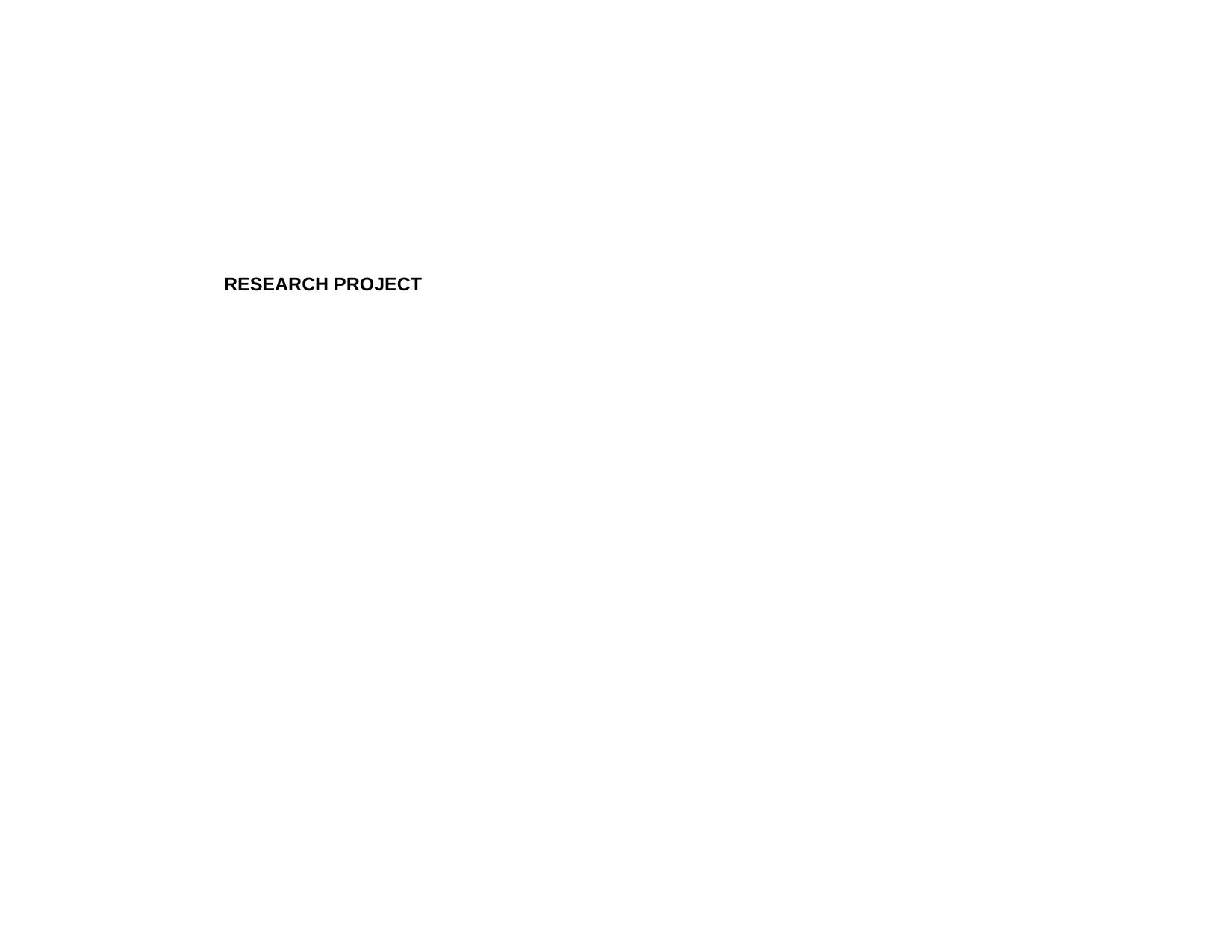
RESEARCH PROJECT
Paraphrase This Document
Need a fresh take? Get an instant paraphrase of this document with our AI Paraphraser
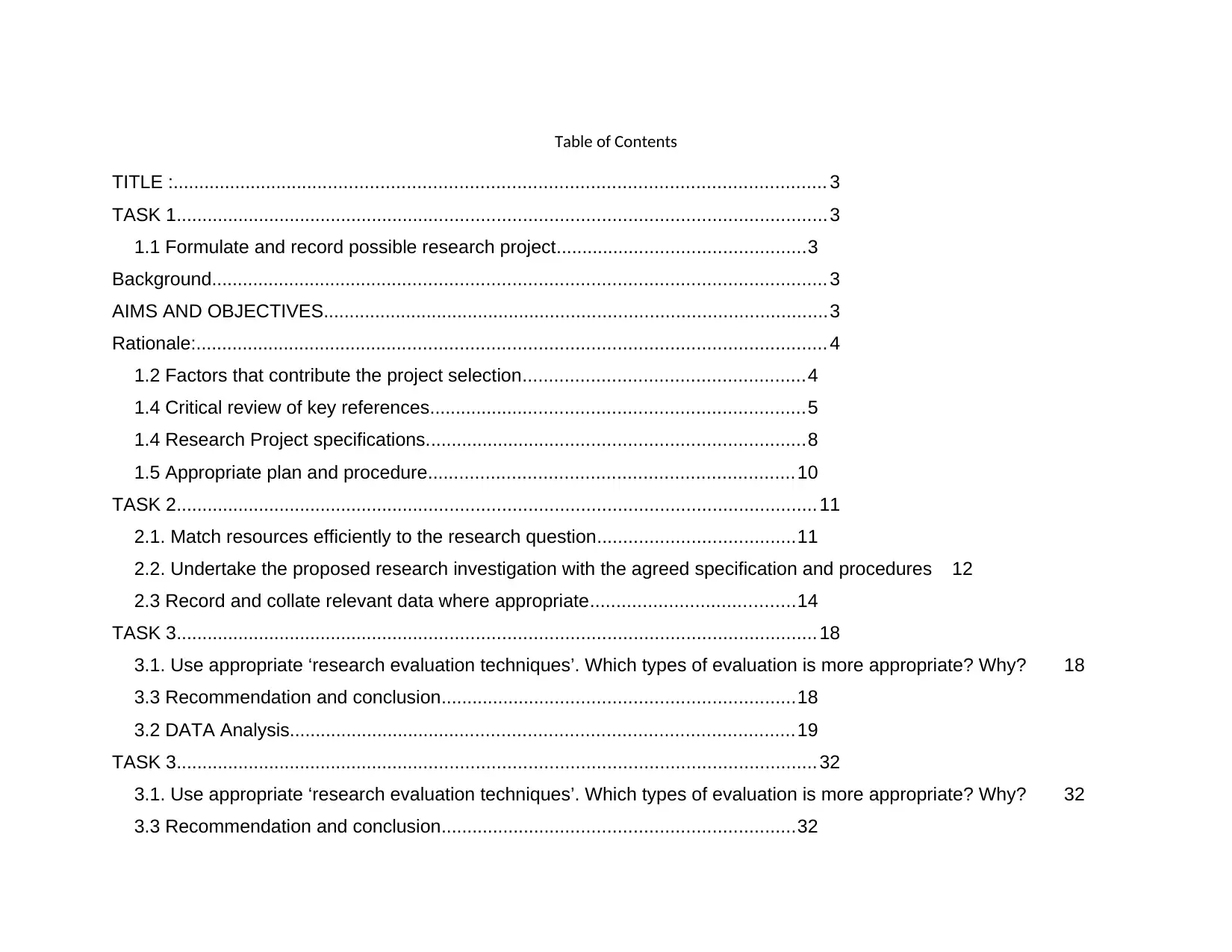
Table of Contents
TITLE :............................................................................................................................. 3
TASK 1.............................................................................................................................3
1.1 Formulate and record possible research project................................................3
Background...................................................................................................................... 3
AIMS AND OBJECTIVES.................................................................................................3
Rationale:......................................................................................................................... 4
1.2 Factors that contribute the project selection......................................................4
1.4 Critical review of key references........................................................................5
1.4 Research Project specifications.........................................................................8
1.5 Appropriate plan and procedure......................................................................10
TASK 2........................................................................................................................... 11
2.1. Match resources efficiently to the research question......................................11
2.2. Undertake the proposed research investigation with the agreed specification and procedures 12
2.3 Record and collate relevant data where appropriate.......................................14
TASK 3........................................................................................................................... 18
3.1. Use appropriate ‘research evaluation techniques’. Which types of evaluation is more appropriate? Why? 18
3.3 Recommendation and conclusion....................................................................18
3.2 DATA Analysis.................................................................................................19
TASK 3........................................................................................................................... 32
3.1. Use appropriate ‘research evaluation techniques’. Which types of evaluation is more appropriate? Why? 32
3.3 Recommendation and conclusion....................................................................32
TITLE :............................................................................................................................. 3
TASK 1.............................................................................................................................3
1.1 Formulate and record possible research project................................................3
Background...................................................................................................................... 3
AIMS AND OBJECTIVES.................................................................................................3
Rationale:......................................................................................................................... 4
1.2 Factors that contribute the project selection......................................................4
1.4 Critical review of key references........................................................................5
1.4 Research Project specifications.........................................................................8
1.5 Appropriate plan and procedure......................................................................10
TASK 2........................................................................................................................... 11
2.1. Match resources efficiently to the research question......................................11
2.2. Undertake the proposed research investigation with the agreed specification and procedures 12
2.3 Record and collate relevant data where appropriate.......................................14
TASK 3........................................................................................................................... 18
3.1. Use appropriate ‘research evaluation techniques’. Which types of evaluation is more appropriate? Why? 18
3.3 Recommendation and conclusion....................................................................18
3.2 DATA Analysis.................................................................................................19
TASK 3........................................................................................................................... 32
3.1. Use appropriate ‘research evaluation techniques’. Which types of evaluation is more appropriate? Why? 32
3.3 Recommendation and conclusion....................................................................32
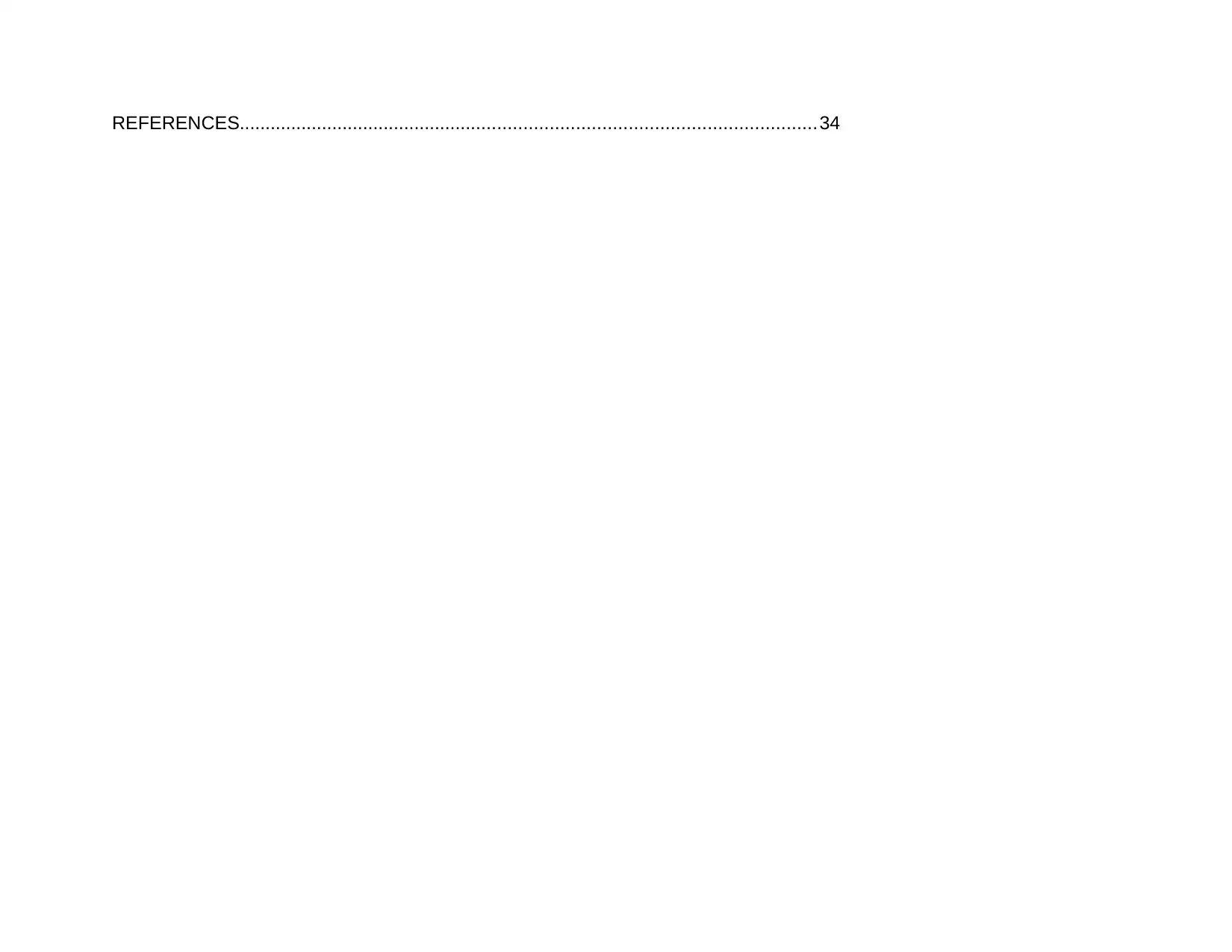
REFERENCES...............................................................................................................34
⊘ This is a preview!⊘
Do you want full access?
Subscribe today to unlock all pages.

Trusted by 1+ million students worldwide
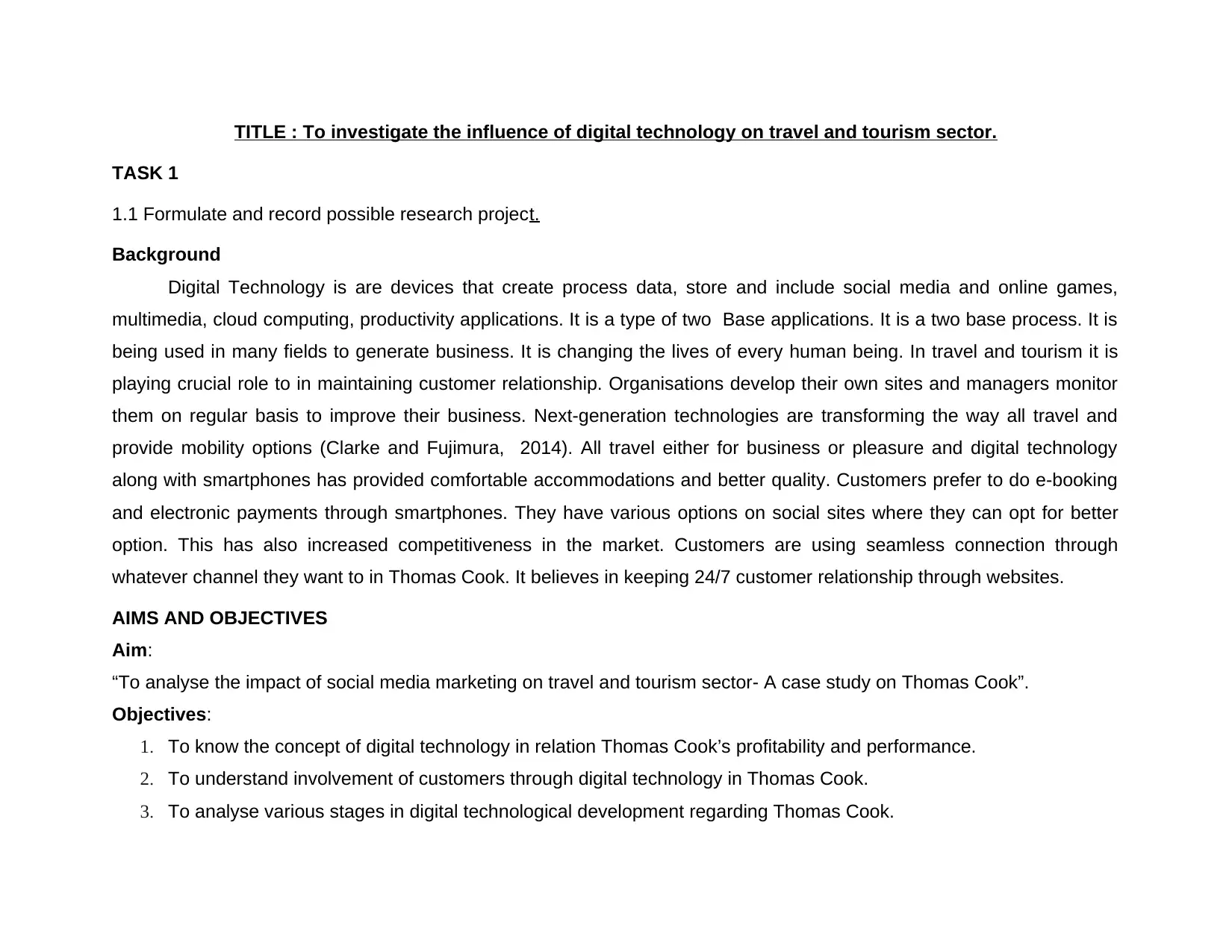
TITLE : To investigate the influence of digital technology on travel and tourism sector.
TASK 1
1.1 Formulate and record possible research project.
Background
Digital Technology is are devices that create process data, store and include social media and online games,
multimedia, cloud computing, productivity applications. It is a type of two Base applications. It is a two base process. It is
being used in many fields to generate business. It is changing the lives of every human being. In travel and tourism it is
playing crucial role to in maintaining customer relationship. Organisations develop their own sites and managers monitor
them on regular basis to improve their business. Next-generation technologies are transforming the way all travel and
provide mobility options (Clarke and Fujimura, 2014). All travel either for business or pleasure and digital technology
along with smartphones has provided comfortable accommodations and better quality. Customers prefer to do e-booking
and electronic payments through smartphones. They have various options on social sites where they can opt for better
option. This has also increased competitiveness in the market. Customers are using seamless connection through
whatever channel they want to in Thomas Cook. It believes in keeping 24/7 customer relationship through websites.
AIMS AND OBJECTIVES
Aim:
“To analyse the impact of social media marketing on travel and tourism sector- A case study on Thomas Cook”.
Objectives:
1. To know the concept of digital technology in relation Thomas Cook’s profitability and performance.
2. To understand involvement of customers through digital technology in Thomas Cook.
3. To analyse various stages in digital technological development regarding Thomas Cook.
TASK 1
1.1 Formulate and record possible research project.
Background
Digital Technology is are devices that create process data, store and include social media and online games,
multimedia, cloud computing, productivity applications. It is a type of two Base applications. It is a two base process. It is
being used in many fields to generate business. It is changing the lives of every human being. In travel and tourism it is
playing crucial role to in maintaining customer relationship. Organisations develop their own sites and managers monitor
them on regular basis to improve their business. Next-generation technologies are transforming the way all travel and
provide mobility options (Clarke and Fujimura, 2014). All travel either for business or pleasure and digital technology
along with smartphones has provided comfortable accommodations and better quality. Customers prefer to do e-booking
and electronic payments through smartphones. They have various options on social sites where they can opt for better
option. This has also increased competitiveness in the market. Customers are using seamless connection through
whatever channel they want to in Thomas Cook. It believes in keeping 24/7 customer relationship through websites.
AIMS AND OBJECTIVES
Aim:
“To analyse the impact of social media marketing on travel and tourism sector- A case study on Thomas Cook”.
Objectives:
1. To know the concept of digital technology in relation Thomas Cook’s profitability and performance.
2. To understand involvement of customers through digital technology in Thomas Cook.
3. To analyse various stages in digital technological development regarding Thomas Cook.
Paraphrase This Document
Need a fresh take? Get an instant paraphrase of this document with our AI Paraphraser
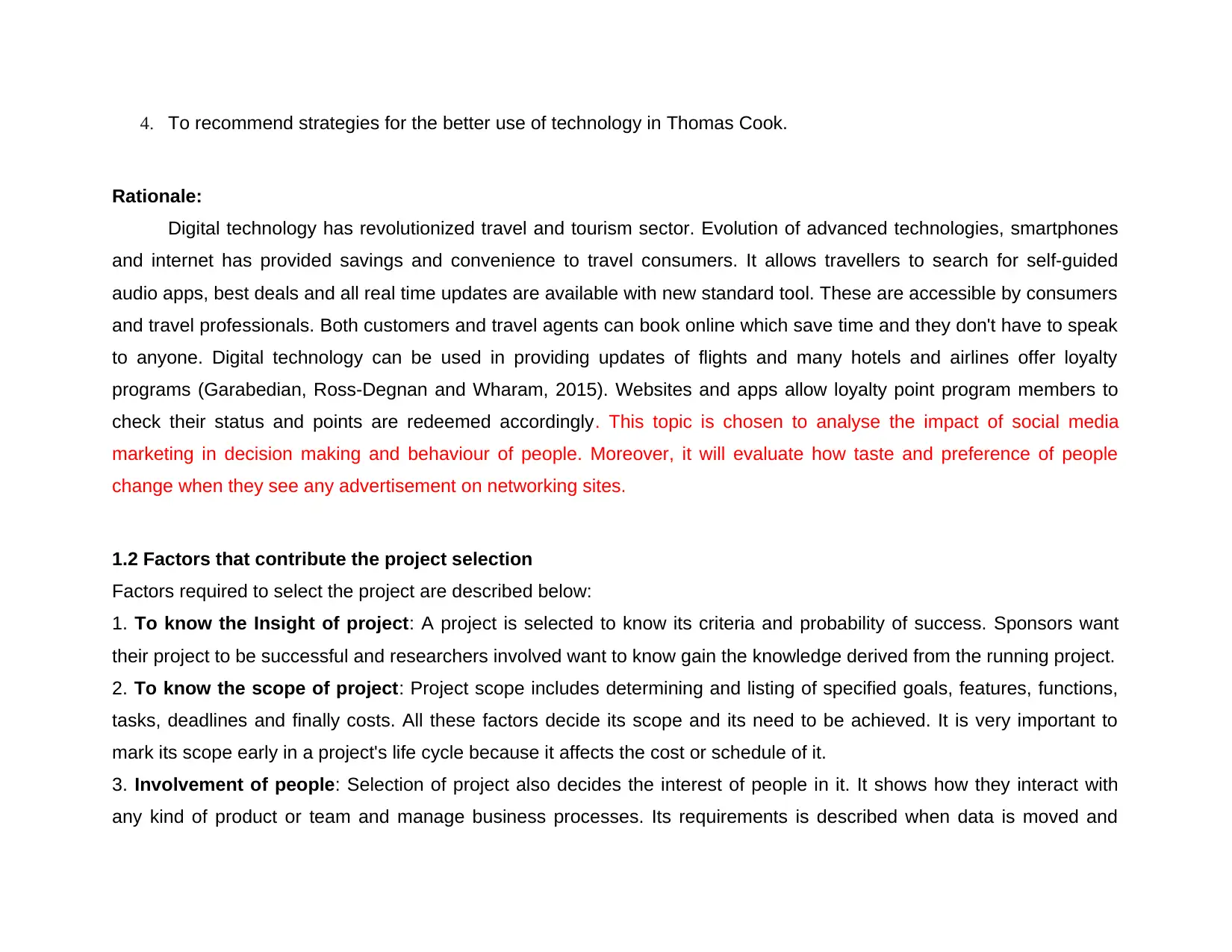
4. To recommend strategies for the better use of technology in Thomas Cook.
Rationale:
Digital technology has revolutionized travel and tourism sector. Evolution of advanced technologies, smartphones
and internet has provided savings and convenience to travel consumers. It allows travellers to search for self-guided
audio apps, best deals and all real time updates are available with new standard tool. These are accessible by consumers
and travel professionals. Both customers and travel agents can book online which save time and they don't have to speak
to anyone. Digital technology can be used in providing updates of flights and many hotels and airlines offer loyalty
programs (Garabedian, Ross-Degnan and Wharam, 2015). Websites and apps allow loyalty point program members to
check their status and points are redeemed accordingly. This topic is chosen to analyse the impact of social media
marketing in decision making and behaviour of people. Moreover, it will evaluate how taste and preference of people
change when they see any advertisement on networking sites.
1.2 Factors that contribute the project selection
Factors required to select the project are described below:
1. To know the Insight of project: A project is selected to know its criteria and probability of success. Sponsors want
their project to be successful and researchers involved want to know gain the knowledge derived from the running project.
2. To know the scope of project: Project scope includes determining and listing of specified goals, features, functions,
tasks, deadlines and finally costs. All these factors decide its scope and its need to be achieved. It is very important to
mark its scope early in a project's life cycle because it affects the cost or schedule of it.
3. Involvement of people: Selection of project also decides the interest of people in it. It shows how they interact with
any kind of product or team and manage business processes. Its requirements is described when data is moved and
Rationale:
Digital technology has revolutionized travel and tourism sector. Evolution of advanced technologies, smartphones
and internet has provided savings and convenience to travel consumers. It allows travellers to search for self-guided
audio apps, best deals and all real time updates are available with new standard tool. These are accessible by consumers
and travel professionals. Both customers and travel agents can book online which save time and they don't have to speak
to anyone. Digital technology can be used in providing updates of flights and many hotels and airlines offer loyalty
programs (Garabedian, Ross-Degnan and Wharam, 2015). Websites and apps allow loyalty point program members to
check their status and points are redeemed accordingly. This topic is chosen to analyse the impact of social media
marketing in decision making and behaviour of people. Moreover, it will evaluate how taste and preference of people
change when they see any advertisement on networking sites.
1.2 Factors that contribute the project selection
Factors required to select the project are described below:
1. To know the Insight of project: A project is selected to know its criteria and probability of success. Sponsors want
their project to be successful and researchers involved want to know gain the knowledge derived from the running project.
2. To know the scope of project: Project scope includes determining and listing of specified goals, features, functions,
tasks, deadlines and finally costs. All these factors decide its scope and its need to be achieved. It is very important to
mark its scope early in a project's life cycle because it affects the cost or schedule of it.
3. Involvement of people: Selection of project also decides the interest of people in it. It shows how they interact with
any kind of product or team and manage business processes. Its requirements is described when data is moved and
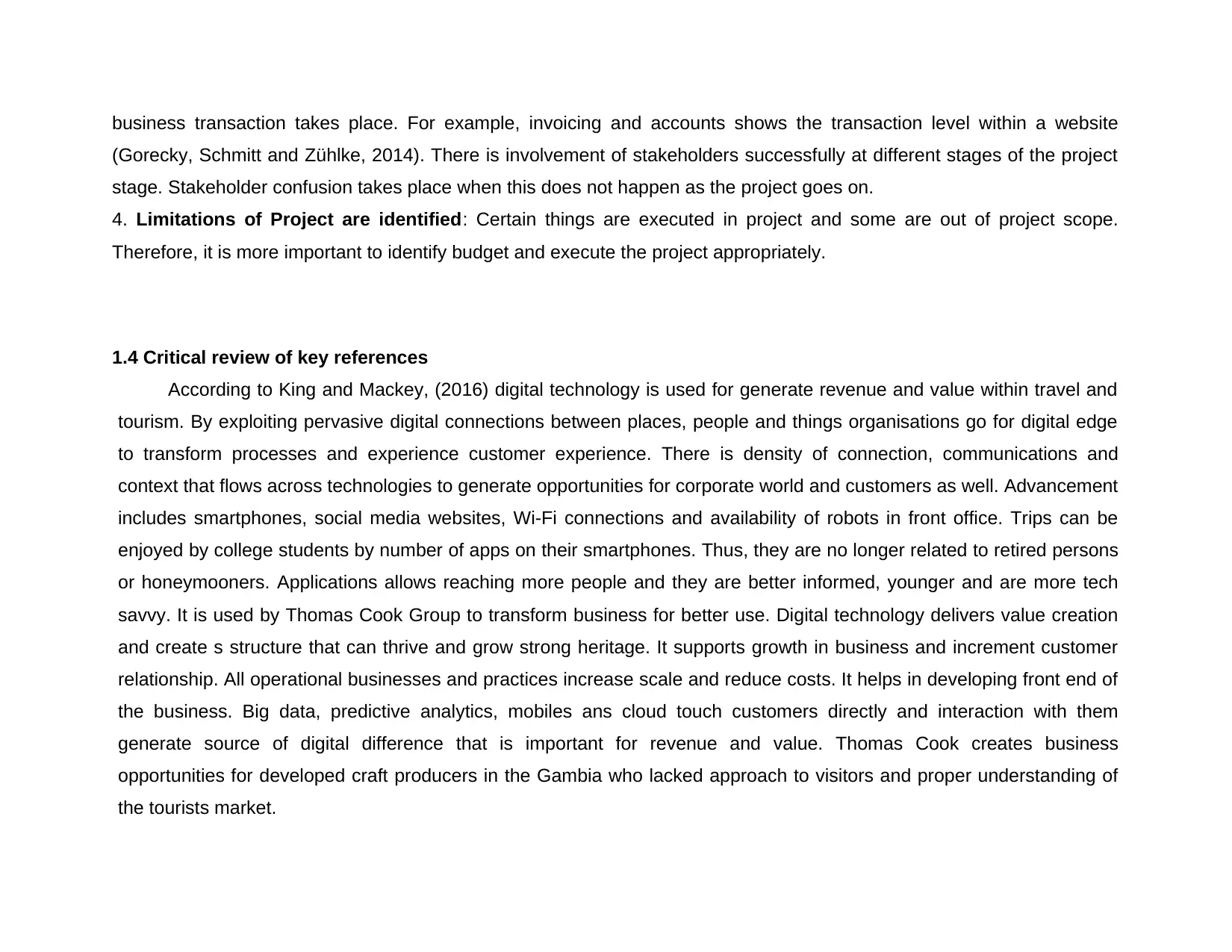
business transaction takes place. For example, invoicing and accounts shows the transaction level within a website
(Gorecky, Schmitt and Zühlke, 2014). There is involvement of stakeholders successfully at different stages of the project
stage. Stakeholder confusion takes place when this does not happen as the project goes on.
4. Limitations of Project are identified: Certain things are executed in project and some are out of project scope.
Therefore, it is more important to identify budget and execute the project appropriately.
1.4 Critical review of key references
According to King and Mackey, (2016) digital technology is used for generate revenue and value within travel and
tourism. By exploiting pervasive digital connections between places, people and things organisations go for digital edge
to transform processes and experience customer experience. There is density of connection, communications and
context that flows across technologies to generate opportunities for corporate world and customers as well. Advancement
includes smartphones, social media websites, Wi-Fi connections and availability of robots in front office. Trips can be
enjoyed by college students by number of apps on their smartphones. Thus, they are no longer related to retired persons
or honeymooners. Applications allows reaching more people and they are better informed, younger and are more tech
savvy. It is used by Thomas Cook Group to transform business for better use. Digital technology delivers value creation
and create s structure that can thrive and grow strong heritage. It supports growth in business and increment customer
relationship. All operational businesses and practices increase scale and reduce costs. It helps in developing front end of
the business. Big data, predictive analytics, mobiles ans cloud touch customers directly and interaction with them
generate source of digital difference that is important for revenue and value. Thomas Cook creates business
opportunities for developed craft producers in the Gambia who lacked approach to visitors and proper understanding of
the tourists market.
(Gorecky, Schmitt and Zühlke, 2014). There is involvement of stakeholders successfully at different stages of the project
stage. Stakeholder confusion takes place when this does not happen as the project goes on.
4. Limitations of Project are identified: Certain things are executed in project and some are out of project scope.
Therefore, it is more important to identify budget and execute the project appropriately.
1.4 Critical review of key references
According to King and Mackey, (2016) digital technology is used for generate revenue and value within travel and
tourism. By exploiting pervasive digital connections between places, people and things organisations go for digital edge
to transform processes and experience customer experience. There is density of connection, communications and
context that flows across technologies to generate opportunities for corporate world and customers as well. Advancement
includes smartphones, social media websites, Wi-Fi connections and availability of robots in front office. Trips can be
enjoyed by college students by number of apps on their smartphones. Thus, they are no longer related to retired persons
or honeymooners. Applications allows reaching more people and they are better informed, younger and are more tech
savvy. It is used by Thomas Cook Group to transform business for better use. Digital technology delivers value creation
and create s structure that can thrive and grow strong heritage. It supports growth in business and increment customer
relationship. All operational businesses and practices increase scale and reduce costs. It helps in developing front end of
the business. Big data, predictive analytics, mobiles ans cloud touch customers directly and interaction with them
generate source of digital difference that is important for revenue and value. Thomas Cook creates business
opportunities for developed craft producers in the Gambia who lacked approach to visitors and proper understanding of
the tourists market.
⊘ This is a preview!⊘
Do you want full access?
Subscribe today to unlock all pages.

Trusted by 1+ million students worldwide
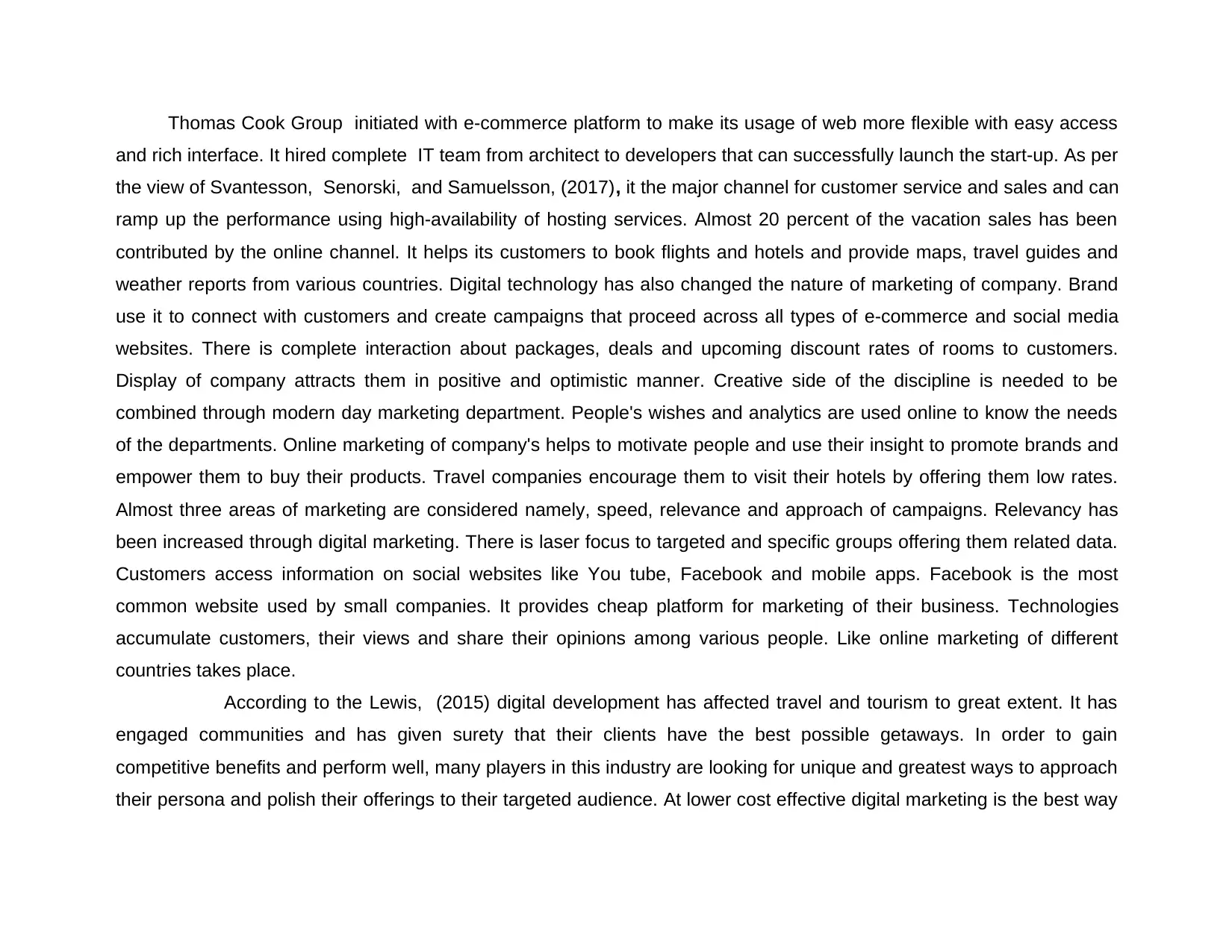
Thomas Cook Group initiated with e-commerce platform to make its usage of web more flexible with easy access
and rich interface. It hired complete IT team from architect to developers that can successfully launch the start-up. As per
the view of Svantesson, Senorski, and Samuelsson, (2017), it the major channel for customer service and sales and can
ramp up the performance using high-availability of hosting services. Almost 20 percent of the vacation sales has been
contributed by the online channel. It helps its customers to book flights and hotels and provide maps, travel guides and
weather reports from various countries. Digital technology has also changed the nature of marketing of company. Brand
use it to connect with customers and create campaigns that proceed across all types of e-commerce and social media
websites. There is complete interaction about packages, deals and upcoming discount rates of rooms to customers.
Display of company attracts them in positive and optimistic manner. Creative side of the discipline is needed to be
combined through modern day marketing department. People's wishes and analytics are used online to know the needs
of the departments. Online marketing of company's helps to motivate people and use their insight to promote brands and
empower them to buy their products. Travel companies encourage them to visit their hotels by offering them low rates.
Almost three areas of marketing are considered namely, speed, relevance and approach of campaigns. Relevancy has
been increased through digital marketing. There is laser focus to targeted and specific groups offering them related data.
Customers access information on social websites like You tube, Facebook and mobile apps. Facebook is the most
common website used by small companies. It provides cheap platform for marketing of their business. Technologies
accumulate customers, their views and share their opinions among various people. Like online marketing of different
countries takes place.
According to the Lewis, (2015) digital development has affected travel and tourism to great extent. It has
engaged communities and has given surety that their clients have the best possible getaways. In order to gain
competitive benefits and perform well, many players in this industry are looking for unique and greatest ways to approach
their persona and polish their offerings to their targeted audience. At lower cost effective digital marketing is the best way
and rich interface. It hired complete IT team from architect to developers that can successfully launch the start-up. As per
the view of Svantesson, Senorski, and Samuelsson, (2017), it the major channel for customer service and sales and can
ramp up the performance using high-availability of hosting services. Almost 20 percent of the vacation sales has been
contributed by the online channel. It helps its customers to book flights and hotels and provide maps, travel guides and
weather reports from various countries. Digital technology has also changed the nature of marketing of company. Brand
use it to connect with customers and create campaigns that proceed across all types of e-commerce and social media
websites. There is complete interaction about packages, deals and upcoming discount rates of rooms to customers.
Display of company attracts them in positive and optimistic manner. Creative side of the discipline is needed to be
combined through modern day marketing department. People's wishes and analytics are used online to know the needs
of the departments. Online marketing of company's helps to motivate people and use their insight to promote brands and
empower them to buy their products. Travel companies encourage them to visit their hotels by offering them low rates.
Almost three areas of marketing are considered namely, speed, relevance and approach of campaigns. Relevancy has
been increased through digital marketing. There is laser focus to targeted and specific groups offering them related data.
Customers access information on social websites like You tube, Facebook and mobile apps. Facebook is the most
common website used by small companies. It provides cheap platform for marketing of their business. Technologies
accumulate customers, their views and share their opinions among various people. Like online marketing of different
countries takes place.
According to the Lewis, (2015) digital development has affected travel and tourism to great extent. It has
engaged communities and has given surety that their clients have the best possible getaways. In order to gain
competitive benefits and perform well, many players in this industry are looking for unique and greatest ways to approach
their persona and polish their offerings to their targeted audience. At lower cost effective digital marketing is the best way
Paraphrase This Document
Need a fresh take? Get an instant paraphrase of this document with our AI Paraphraser
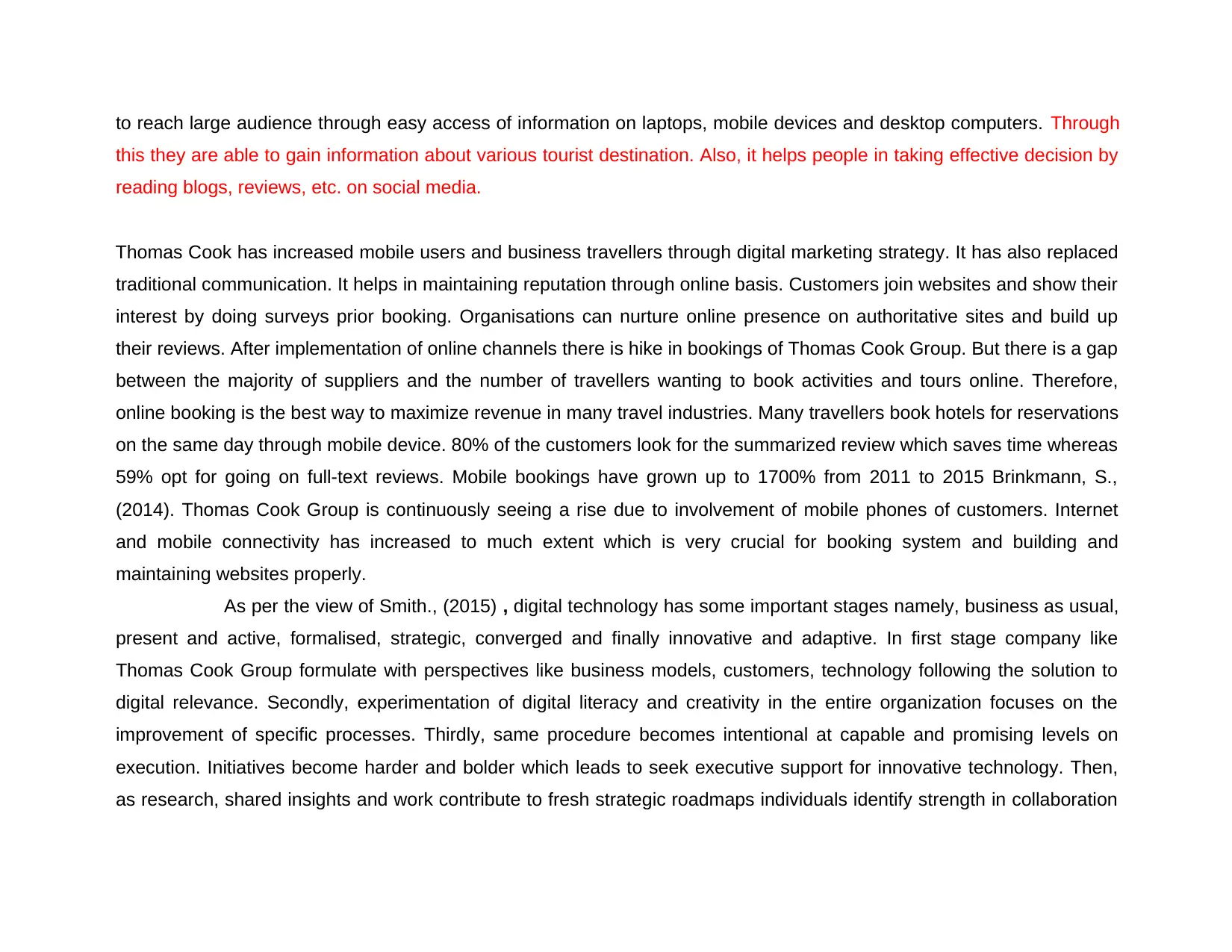
to reach large audience through easy access of information on laptops, mobile devices and desktop computers. Through
this they are able to gain information about various tourist destination. Also, it helps people in taking effective decision by
reading blogs, reviews, etc. on social media.
Thomas Cook has increased mobile users and business travellers through digital marketing strategy. It has also replaced
traditional communication. It helps in maintaining reputation through online basis. Customers join websites and show their
interest by doing surveys prior booking. Organisations can nurture online presence on authoritative sites and build up
their reviews. After implementation of online channels there is hike in bookings of Thomas Cook Group. But there is a gap
between the majority of suppliers and the number of travellers wanting to book activities and tours online. Therefore,
online booking is the best way to maximize revenue in many travel industries. Many travellers book hotels for reservations
on the same day through mobile device. 80% of the customers look for the summarized review which saves time whereas
59% opt for going on full-text reviews. Mobile bookings have grown up to 1700% from 2011 to 2015 Brinkmann, S.,
(2014). Thomas Cook Group is continuously seeing a rise due to involvement of mobile phones of customers. Internet
and mobile connectivity has increased to much extent which is very crucial for booking system and building and
maintaining websites properly.
As per the view of Smith., (2015) , digital technology has some important stages namely, business as usual,
present and active, formalised, strategic, converged and finally innovative and adaptive. In first stage company like
Thomas Cook Group formulate with perspectives like business models, customers, technology following the solution to
digital relevance. Secondly, experimentation of digital literacy and creativity in the entire organization focuses on the
improvement of specific processes. Thirdly, same procedure becomes intentional at capable and promising levels on
execution. Initiatives become harder and bolder which leads to seek executive support for innovative technology. Then,
as research, shared insights and work contribute to fresh strategic roadmaps individuals identify strength in collaboration
this they are able to gain information about various tourist destination. Also, it helps people in taking effective decision by
reading blogs, reviews, etc. on social media.
Thomas Cook has increased mobile users and business travellers through digital marketing strategy. It has also replaced
traditional communication. It helps in maintaining reputation through online basis. Customers join websites and show their
interest by doing surveys prior booking. Organisations can nurture online presence on authoritative sites and build up
their reviews. After implementation of online channels there is hike in bookings of Thomas Cook Group. But there is a gap
between the majority of suppliers and the number of travellers wanting to book activities and tours online. Therefore,
online booking is the best way to maximize revenue in many travel industries. Many travellers book hotels for reservations
on the same day through mobile device. 80% of the customers look for the summarized review which saves time whereas
59% opt for going on full-text reviews. Mobile bookings have grown up to 1700% from 2011 to 2015 Brinkmann, S.,
(2014). Thomas Cook Group is continuously seeing a rise due to involvement of mobile phones of customers. Internet
and mobile connectivity has increased to much extent which is very crucial for booking system and building and
maintaining websites properly.
As per the view of Smith., (2015) , digital technology has some important stages namely, business as usual,
present and active, formalised, strategic, converged and finally innovative and adaptive. In first stage company like
Thomas Cook Group formulate with perspectives like business models, customers, technology following the solution to
digital relevance. Secondly, experimentation of digital literacy and creativity in the entire organization focuses on the
improvement of specific processes. Thirdly, same procedure becomes intentional at capable and promising levels on
execution. Initiatives become harder and bolder which leads to seek executive support for innovative technology. Then,
as research, shared insights and work contribute to fresh strategic roadmaps individuals identify strength in collaboration
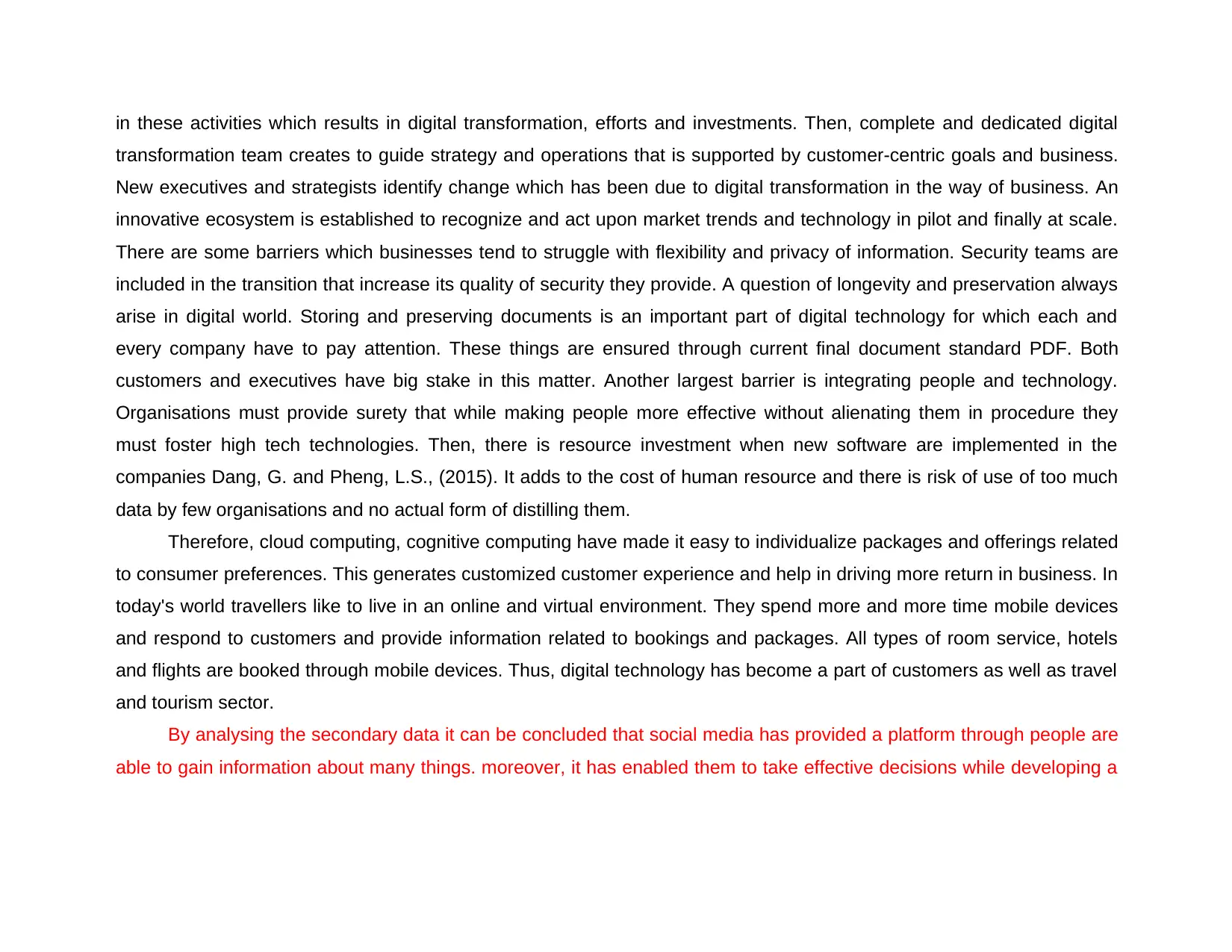
in these activities which results in digital transformation, efforts and investments. Then, complete and dedicated digital
transformation team creates to guide strategy and operations that is supported by customer-centric goals and business.
New executives and strategists identify change which has been due to digital transformation in the way of business. An
innovative ecosystem is established to recognize and act upon market trends and technology in pilot and finally at scale.
There are some barriers which businesses tend to struggle with flexibility and privacy of information. Security teams are
included in the transition that increase its quality of security they provide. A question of longevity and preservation always
arise in digital world. Storing and preserving documents is an important part of digital technology for which each and
every company have to pay attention. These things are ensured through current final document standard PDF. Both
customers and executives have big stake in this matter. Another largest barrier is integrating people and technology.
Organisations must provide surety that while making people more effective without alienating them in procedure they
must foster high tech technologies. Then, there is resource investment when new software are implemented in the
companies Dang, G. and Pheng, L.S., (2015). It adds to the cost of human resource and there is risk of use of too much
data by few organisations and no actual form of distilling them.
Therefore, cloud computing, cognitive computing have made it easy to individualize packages and offerings related
to consumer preferences. This generates customized customer experience and help in driving more return in business. In
today's world travellers like to live in an online and virtual environment. They spend more and more time mobile devices
and respond to customers and provide information related to bookings and packages. All types of room service, hotels
and flights are booked through mobile devices. Thus, digital technology has become a part of customers as well as travel
and tourism sector.
By analysing the secondary data it can be concluded that social media has provided a platform through people are
able to gain information about many things. moreover, it has enabled them to take effective decisions while developing a
transformation team creates to guide strategy and operations that is supported by customer-centric goals and business.
New executives and strategists identify change which has been due to digital transformation in the way of business. An
innovative ecosystem is established to recognize and act upon market trends and technology in pilot and finally at scale.
There are some barriers which businesses tend to struggle with flexibility and privacy of information. Security teams are
included in the transition that increase its quality of security they provide. A question of longevity and preservation always
arise in digital world. Storing and preserving documents is an important part of digital technology for which each and
every company have to pay attention. These things are ensured through current final document standard PDF. Both
customers and executives have big stake in this matter. Another largest barrier is integrating people and technology.
Organisations must provide surety that while making people more effective without alienating them in procedure they
must foster high tech technologies. Then, there is resource investment when new software are implemented in the
companies Dang, G. and Pheng, L.S., (2015). It adds to the cost of human resource and there is risk of use of too much
data by few organisations and no actual form of distilling them.
Therefore, cloud computing, cognitive computing have made it easy to individualize packages and offerings related
to consumer preferences. This generates customized customer experience and help in driving more return in business. In
today's world travellers like to live in an online and virtual environment. They spend more and more time mobile devices
and respond to customers and provide information related to bookings and packages. All types of room service, hotels
and flights are booked through mobile devices. Thus, digital technology has become a part of customers as well as travel
and tourism sector.
By analysing the secondary data it can be concluded that social media has provided a platform through people are
able to gain information about many things. moreover, it has enabled them to take effective decisions while developing a
⊘ This is a preview!⊘
Do you want full access?
Subscribe today to unlock all pages.

Trusted by 1+ million students worldwide
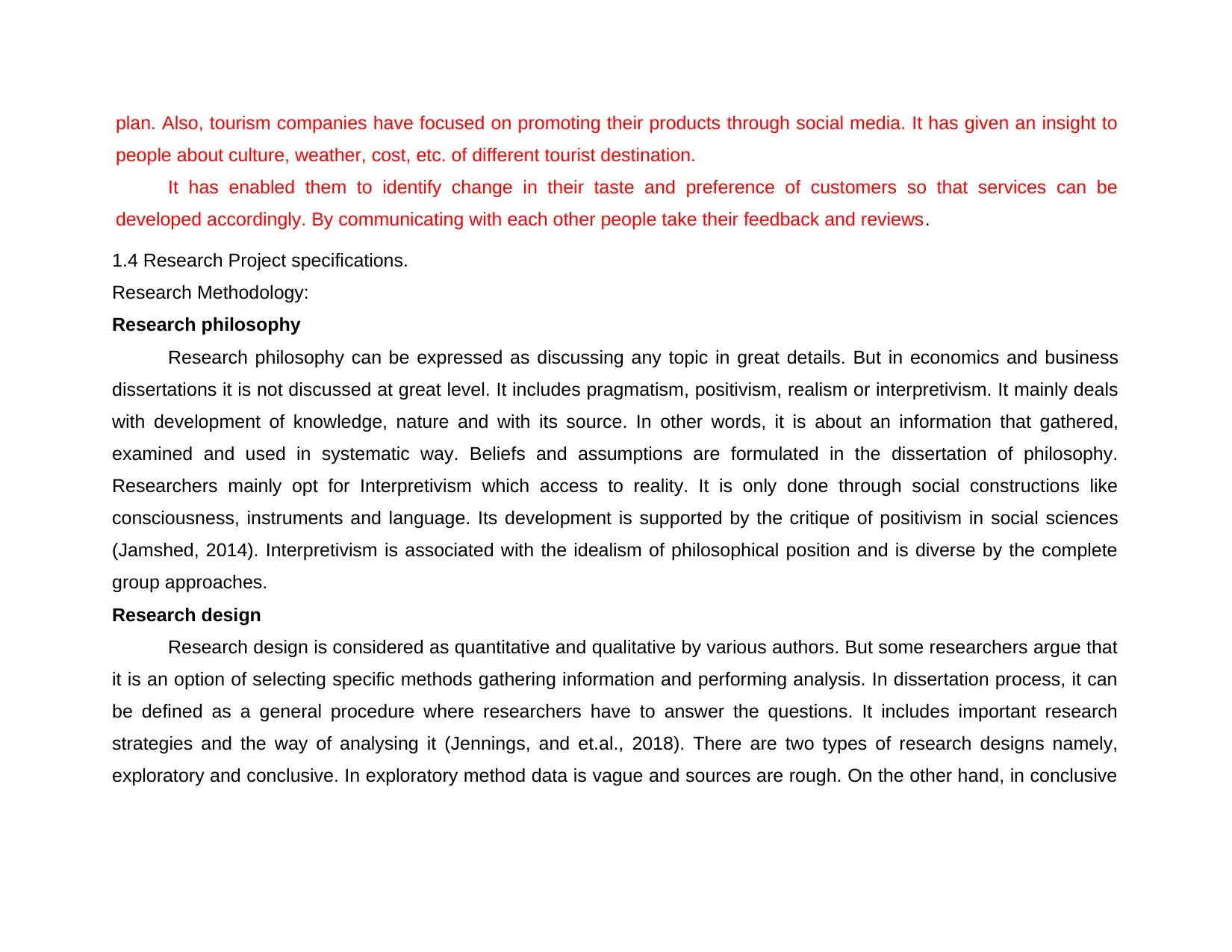
plan. Also, tourism companies have focused on promoting their products through social media. It has given an insight to
people about culture, weather, cost, etc. of different tourist destination.
It has enabled them to identify change in their taste and preference of customers so that services can be
developed accordingly. By communicating with each other people take their feedback and reviews.
1.4 Research Project specifications.
Research Methodology:
Research philosophy
Research philosophy can be expressed as discussing any topic in great details. But in economics and business
dissertations it is not discussed at great level. It includes pragmatism, positivism, realism or interpretivism. It mainly deals
with development of knowledge, nature and with its source. In other words, it is about an information that gathered,
examined and used in systematic way. Beliefs and assumptions are formulated in the dissertation of philosophy.
Researchers mainly opt for Interpretivism which access to reality. It is only done through social constructions like
consciousness, instruments and language. Its development is supported by the critique of positivism in social sciences
(Jamshed, 2014). Interpretivism is associated with the idealism of philosophical position and is diverse by the complete
group approaches.
Research design
Research design is considered as quantitative and qualitative by various authors. But some researchers argue that
it is an option of selecting specific methods gathering information and performing analysis. In dissertation process, it can
be defined as a general procedure where researchers have to answer the questions. It includes important research
strategies and the way of analysing it (Jennings, and et.al., 2018). There are two types of research designs namely,
exploratory and conclusive. In exploratory method data is vague and sources are rough. On the other hand, in conclusive
people about culture, weather, cost, etc. of different tourist destination.
It has enabled them to identify change in their taste and preference of customers so that services can be
developed accordingly. By communicating with each other people take their feedback and reviews.
1.4 Research Project specifications.
Research Methodology:
Research philosophy
Research philosophy can be expressed as discussing any topic in great details. But in economics and business
dissertations it is not discussed at great level. It includes pragmatism, positivism, realism or interpretivism. It mainly deals
with development of knowledge, nature and with its source. In other words, it is about an information that gathered,
examined and used in systematic way. Beliefs and assumptions are formulated in the dissertation of philosophy.
Researchers mainly opt for Interpretivism which access to reality. It is only done through social constructions like
consciousness, instruments and language. Its development is supported by the critique of positivism in social sciences
(Jamshed, 2014). Interpretivism is associated with the idealism of philosophical position and is diverse by the complete
group approaches.
Research design
Research design is considered as quantitative and qualitative by various authors. But some researchers argue that
it is an option of selecting specific methods gathering information and performing analysis. In dissertation process, it can
be defined as a general procedure where researchers have to answer the questions. It includes important research
strategies and the way of analysing it (Jennings, and et.al., 2018). There are two types of research designs namely,
exploratory and conclusive. In exploratory method data is vague and sources are rough. On the other hand, in conclusive
Paraphrase This Document
Need a fresh take? Get an instant paraphrase of this document with our AI Paraphraser
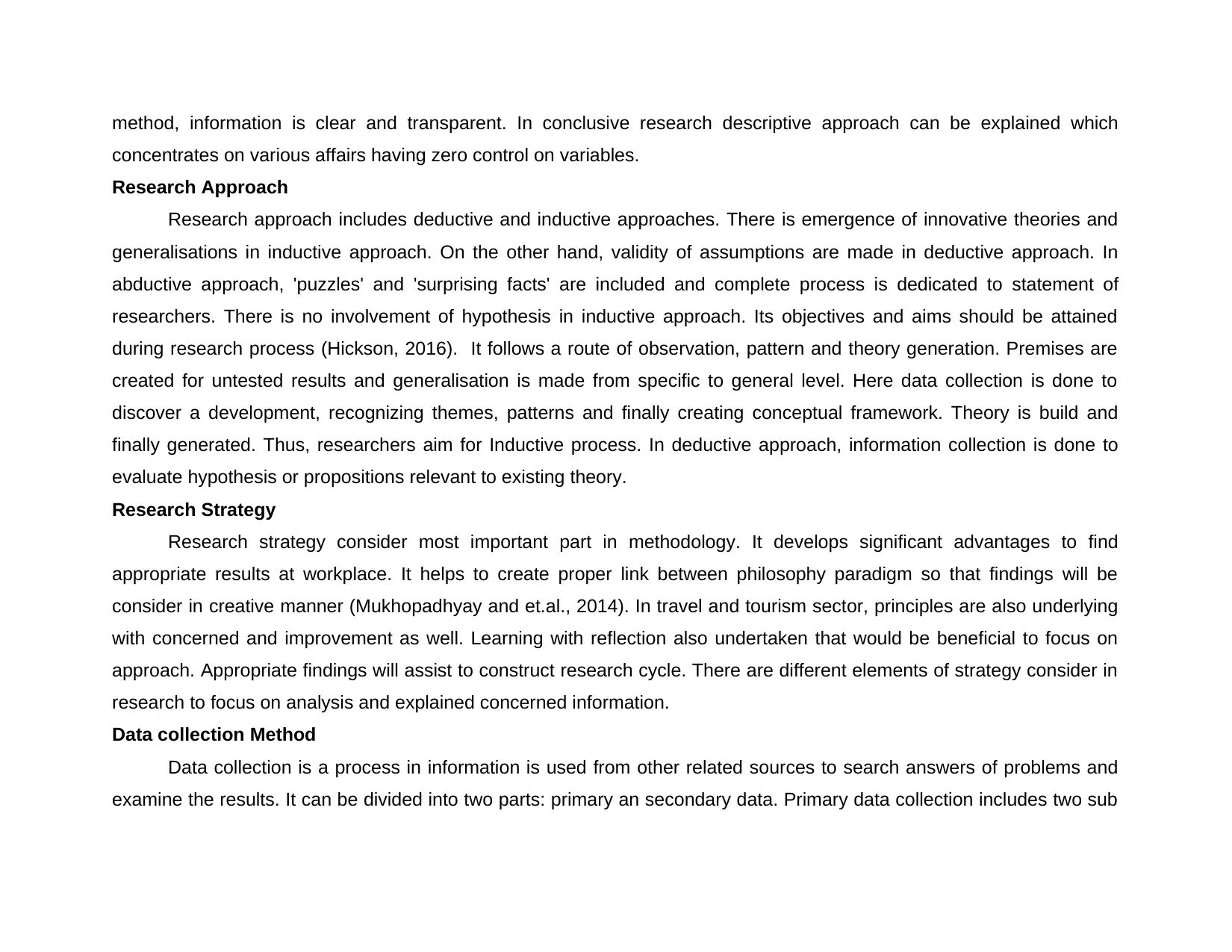
method, information is clear and transparent. In conclusive research descriptive approach can be explained which
concentrates on various affairs having zero control on variables.
Research Approach
Research approach includes deductive and inductive approaches. There is emergence of innovative theories and
generalisations in inductive approach. On the other hand, validity of assumptions are made in deductive approach. In
abductive approach, 'puzzles' and 'surprising facts' are included and complete process is dedicated to statement of
researchers. There is no involvement of hypothesis in inductive approach. Its objectives and aims should be attained
during research process (Hickson, 2016). It follows a route of observation, pattern and theory generation. Premises are
created for untested results and generalisation is made from specific to general level. Here data collection is done to
discover a development, recognizing themes, patterns and finally creating conceptual framework. Theory is build and
finally generated. Thus, researchers aim for Inductive process. In deductive approach, information collection is done to
evaluate hypothesis or propositions relevant to existing theory.
Research Strategy
Research strategy consider most important part in methodology. It develops significant advantages to find
appropriate results at workplace. It helps to create proper link between philosophy paradigm so that findings will be
consider in creative manner (Mukhopadhyay and et.al., 2014). In travel and tourism sector, principles are also underlying
with concerned and improvement as well. Learning with reflection also undertaken that would be beneficial to focus on
approach. Appropriate findings will assist to construct research cycle. There are different elements of strategy consider in
research to focus on analysis and explained concerned information.
Data collection Method
Data collection is a process in information is used from other related sources to search answers of problems and
examine the results. It can be divided into two parts: primary an secondary data. Primary data collection includes two sub
concentrates on various affairs having zero control on variables.
Research Approach
Research approach includes deductive and inductive approaches. There is emergence of innovative theories and
generalisations in inductive approach. On the other hand, validity of assumptions are made in deductive approach. In
abductive approach, 'puzzles' and 'surprising facts' are included and complete process is dedicated to statement of
researchers. There is no involvement of hypothesis in inductive approach. Its objectives and aims should be attained
during research process (Hickson, 2016). It follows a route of observation, pattern and theory generation. Premises are
created for untested results and generalisation is made from specific to general level. Here data collection is done to
discover a development, recognizing themes, patterns and finally creating conceptual framework. Theory is build and
finally generated. Thus, researchers aim for Inductive process. In deductive approach, information collection is done to
evaluate hypothesis or propositions relevant to existing theory.
Research Strategy
Research strategy consider most important part in methodology. It develops significant advantages to find
appropriate results at workplace. It helps to create proper link between philosophy paradigm so that findings will be
consider in creative manner (Mukhopadhyay and et.al., 2014). In travel and tourism sector, principles are also underlying
with concerned and improvement as well. Learning with reflection also undertaken that would be beneficial to focus on
approach. Appropriate findings will assist to construct research cycle. There are different elements of strategy consider in
research to focus on analysis and explained concerned information.
Data collection Method
Data collection is a process in information is used from other related sources to search answers of problems and
examine the results. It can be divided into two parts: primary an secondary data. Primary data collection includes two sub
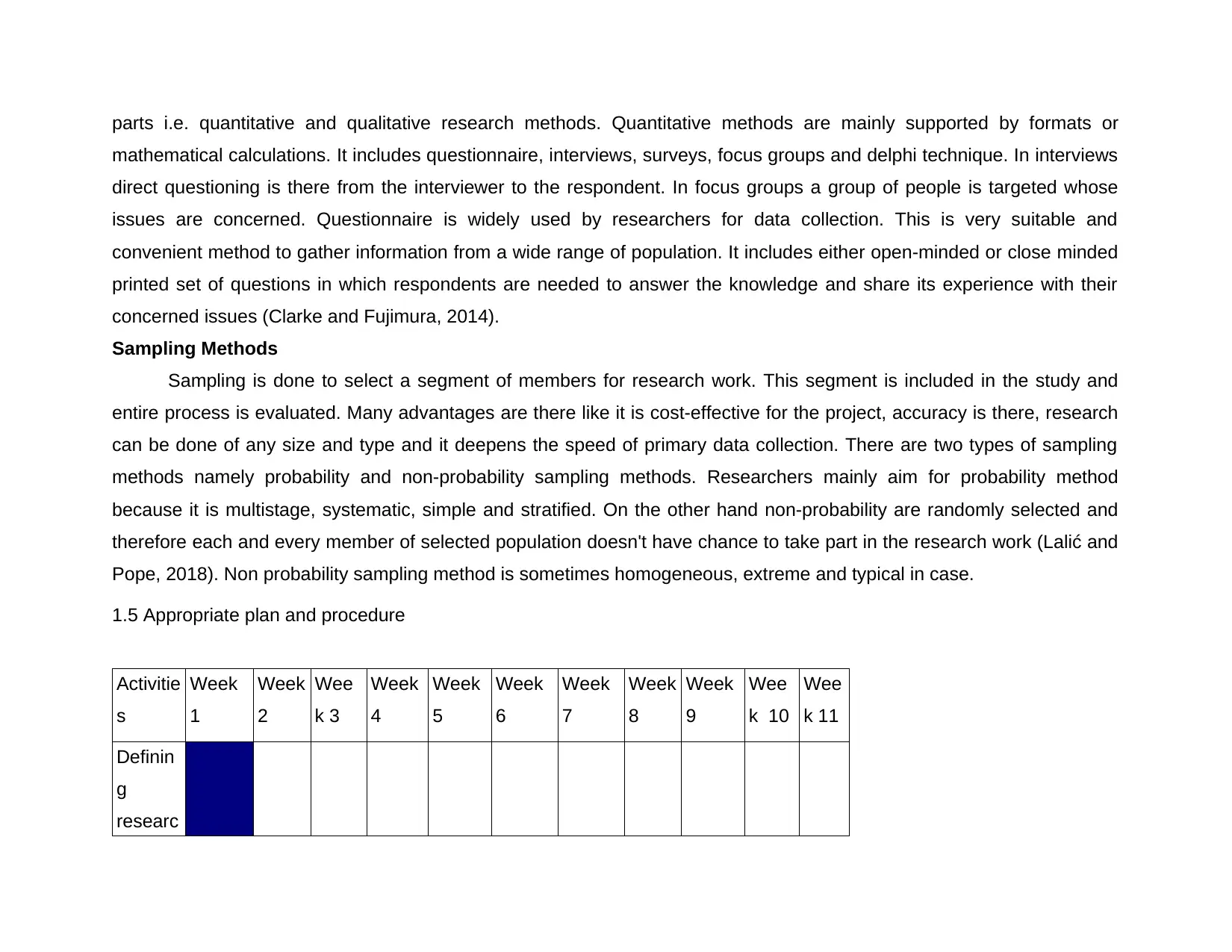
parts i.e. quantitative and qualitative research methods. Quantitative methods are mainly supported by formats or
mathematical calculations. It includes questionnaire, interviews, surveys, focus groups and delphi technique. In interviews
direct questioning is there from the interviewer to the respondent. In focus groups a group of people is targeted whose
issues are concerned. Questionnaire is widely used by researchers for data collection. This is very suitable and
convenient method to gather information from a wide range of population. It includes either open-minded or close minded
printed set of questions in which respondents are needed to answer the knowledge and share its experience with their
concerned issues (Clarke and Fujimura, 2014).
Sampling Methods
Sampling is done to select a segment of members for research work. This segment is included in the study and
entire process is evaluated. Many advantages are there like it is cost-effective for the project, accuracy is there, research
can be done of any size and type and it deepens the speed of primary data collection. There are two types of sampling
methods namely probability and non-probability sampling methods. Researchers mainly aim for probability method
because it is multistage, systematic, simple and stratified. On the other hand non-probability are randomly selected and
therefore each and every member of selected population doesn't have chance to take part in the research work (Lalić and
Pope, 2018). Non probability sampling method is sometimes homogeneous, extreme and typical in case.
1.5 Appropriate plan and procedure
Activitie
s
Week
1
Week
2
Wee
k 3
Week
4
Week
5
Week
6
Week
7
Week
8
Week
9
Wee
k 10
Wee
k 11
Definin
g
researc
mathematical calculations. It includes questionnaire, interviews, surveys, focus groups and delphi technique. In interviews
direct questioning is there from the interviewer to the respondent. In focus groups a group of people is targeted whose
issues are concerned. Questionnaire is widely used by researchers for data collection. This is very suitable and
convenient method to gather information from a wide range of population. It includes either open-minded or close minded
printed set of questions in which respondents are needed to answer the knowledge and share its experience with their
concerned issues (Clarke and Fujimura, 2014).
Sampling Methods
Sampling is done to select a segment of members for research work. This segment is included in the study and
entire process is evaluated. Many advantages are there like it is cost-effective for the project, accuracy is there, research
can be done of any size and type and it deepens the speed of primary data collection. There are two types of sampling
methods namely probability and non-probability sampling methods. Researchers mainly aim for probability method
because it is multistage, systematic, simple and stratified. On the other hand non-probability are randomly selected and
therefore each and every member of selected population doesn't have chance to take part in the research work (Lalić and
Pope, 2018). Non probability sampling method is sometimes homogeneous, extreme and typical in case.
1.5 Appropriate plan and procedure
Activitie
s
Week
1
Week
2
Wee
k 3
Week
4
Week
5
Week
6
Week
7
Week
8
Week
9
Wee
k 10
Wee
k 11
Definin
g
researc
⊘ This is a preview!⊘
Do you want full access?
Subscribe today to unlock all pages.

Trusted by 1+ million students worldwide
1 out of 43
Related Documents
Your All-in-One AI-Powered Toolkit for Academic Success.
+13062052269
info@desklib.com
Available 24*7 on WhatsApp / Email
![[object Object]](/_next/static/media/star-bottom.7253800d.svg)
Unlock your academic potential
Copyright © 2020–2025 A2Z Services. All Rights Reserved. Developed and managed by ZUCOL.




